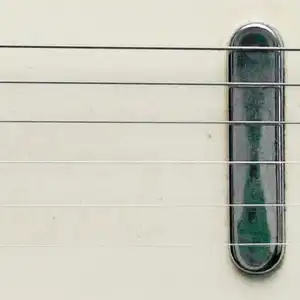Top 10 Guitar String Myths Debunked


Be sure to subscribe to our YouTube channel to keep up with more great videos like this one.
Today we're talking about 10 of the biggest guitar string myths that we either see, or hear about, or get asked about by customers. Some of these things are a little bit more at a beginner level, that might seem obvious to some of you, but we still get asked them a lot, so we wanted to make sure to cover them here. Others of them are a little bit more technical, or a little bit more advanced. I'm sure some of it will be relevant to you, regardless of where you are in your playing career. All right, so, in no particular order...Guitar String Myth #1: Playing heavier-gauge guitar strings is going to mess up your guitar's neck.
The truth is, necks can take a lot more tension than a lot of players typically think. Most guitars were designed with really heavy gauge strings like .013s or .014s in mind. This was pretty common back in the '40s. And so, playing .010s or .011s or even .012s, something that we think of as heavy today, really isn't any big deal for your guitar's neck. Even if you're playing .013s and tuning to standard, it's really not a big issue. Most necks were designed to account for that. Sure, you might have to make some truss rod adjustments depending on a number of different factors, but in most cases, it's not going to cause any damage or any harm to your guitar. Additionally, if you're turning down, you might find that you have even less tension at a heavier gauge than you would have otherwise. If you're playing .013s in B, that's going to pretty much be the exact same thing as playing .010s in E. So, even if you're going as heavy as a .090 on the bottom of an electric guitar string set, if you're tuning down to super, super low E, that's not an issue at all. That's not providing any more tension there than a much lighter string would at a higher tuning.Guitar String Myth #2: Break-testing strings gives you an accurate understanding of how those strings will perform in the real world.
What I'm talking about here is what you'll see from a lot of companies, where they're using break tests to gauge a string's durability. They're just applying more and more tension on a given guitar string, to see at what amount of tension that string will fail and snap. This is a lot of the reason that different companies will say a given line of strings is now "30% stronger" than a previous set of strings, because they can actually measure that through a break test. Now, the truth is, while this tells you a little bit about the string's overall strength and its overall construction, it doesn't necessarily give you an accurate picture of how that string will wear in actual play. The way that you play your guitar, you're putting different amounts of tension on it as you bend or do things like that, but it's not this massive amount of tension. It's more that string being able to come up in tension and come back down in tension really regularly over a long period of time. Strings die because they lose their elasticity. This usually happens because of corrosion at the core level of the string, which happens due to humidity, the sweat on your hands, how often you clean your guitar's strings, how you play it, on and on and on. There's a lot of different factors that contribute to this, but ultimately the picture of it is that you're applying different pressure on your guitar, it's getting a little bit more tension, and then going back down in tension, over and over and over again over a period of months and months. That's a very, very different experience than simply taking a fresh string and apply a ton of force to it to see at what point it will break.Guitar String Myth #3: Plain strings are different between different sets.
What I'm talking about here are the plain steel strings, which are the top three strings in most electric guitar string sets, or the top two strings in most acoustic guitar string sets. A lot of players will think that the plain strings are different, or they have different alloys in them to make them fit differently in these different sets, and as we covered in a previous article, that's not true. Those strings are the exact same steel strings. The only difference might be that the gauges that are going to find their way into a different set. I saw a comment recently on a video from actually another string manufacturer, where a player had bought a set of pure nickel strings, and was really upset to find out that the plain steel strings weren't pure nickel, they were just using steel strings in the set. That's the truth no matter who you're getting it from, though. You're never going to find pure nickel strings on your plain strings. It wouldn't be strong enough to hold up.Guitar String Myth #4: Breaking a plain string from a given manufacturer's set is a bad indicator of that company's quality control.
Now, plain steel strings are made of a steel commonly referred to as music wire. It was invented for piano strings way, way back, a few centuries ago, and it's been in use ever since. Music Wire isn't just used in strings. It's used in everything from bridge cables to different mechanical engineering purposes where you need a really, really strong piece of wire. As such, this is an industry standard, so really, no matter where you're getting your music wire from, it is essentially the exact same wire. You can't have different wire drawing companies making totally different things and marketing it as music wire—when you're building a bridge you need a level of certainty as to how the wire you're using is going to perform, so it needs to be standardized. As such, when you're getting a plain steel string from a given manufacturer, in all likelihood, it's fairly similar to a plain steel string from another manufacturer. The biggest difference between different manufacturers when it comes to plain strings are in the twist lock down at the ball end. They're all doing that themselves, so if you encounter some breakage at a twist lock, that might be an indication of how that manufacturer has their machinery set up to perform that twist lock, and different elements of the actual quality of the string itself from the manufacturer. But if you're breaking the string midway, it isn't necessarily an indicator of that individual company. Certainly, there are things like storage issues, and how long they're having that wire set up or lying around before you're getting that string that can affect how likely it is to break, but ultimately, the wire itself is going to be pretty darn similar from one company to another.Guitar String Myth #5: There is actually only one string manufacturer that makes all the strings for all the different brands of strings that you see in the world.
This myth is actually one of my personal favorites. I hear it all the time, whether I'm at trade shows, or in comments on ads that we run on Facebook, or things like that. Now, this is totally untrue. There are literally dozens of different companies that manufacture guitar strings, or strings for different instruments, in the US alone—let alone worldwide—but I still hear this one all the time. I feel like everybody heard it over the counter at a music store somewhere and just took it as fact. But it actually isn't true. You can see a lot of video from different companies making strings, that will show you if you're a disbeliever that in fact, a lot of different companies do make guitar strings. The big misunderstanding that I think underpins a lot of this myth is that people don't really understand what exactly the equipment that's used to make guitar strings looks like. I think a lot of folks think that it's some giant mechanized contraption, that you push a button on the side and it spits out a guitar string in some sort of tray like a vending machine, or something like that. That's not really true. We're talking about, at its basest, core elements, a motor that's spinning your core wire, and some sort of guide or way of ensuring the wrap wire is getting on there across the length of the string. There's a lot of technical points and fine details that go into making a perfect string, but in and of itself, the machinery is not all that complex. I bring this up because, as you can imagine, most companies want to eliminate middlemen and cut their costs, and so along the way, if you have a company that's been making strings—or selling strings, rather—for decades and decades, when one simple string winding machine might cost as much as a farm tractor, it's pretty obvious that the ones that want to make their strings are going to eventually make that jump and start making those strings themselves, rather than paying somebody else to do it. That said, where I think this myth comes from is that there are a lot of string companies that are using third-party manufacturing in order to make their strings. There's not necessarily anything wrong with that. It's all about what type of business you want to run. There's a reason that companies like Nike or Apple are using typically third-party manufacturers to make their products, because running a brand is a little bit of a different business than running a manufacturing company. So, while unfortunately it can be a little bit hard to tell which companies are actually making their strings, and which are using a third-party manufacturer, in my experience, one of the easiest rules of thumb to keep in mind is that a lot of companies whose primary product is something other than strings, are frequently using third-party manufacturing because they want to sell guitar strings, but they don't necessarily want to get into the business of manufacturing them. That said, there certainly are companies that sell guitars primarily and do make their strings, and there are others that don't. It just depends on that individual company, how they want to run their business, and what they think is the most effective way to get the product that they really want, and they're willing to put their name on. So, while it's true that if you're looking at a shelf of guitar strings at a given point in time, some of them might be made by that company, and some of them might be made to their specs by a different company, I promise there's not just one super, all-knowing guitar string manufacturing company that's making strings for everybody, and everybody slaps different labels on it. That's just not true, and it's never really been true. I don't know where the myth comes from, but I'm tired of hearing about it.Guitar String Myth #6: Guitar strings can be pre-stretched by the manufacturer, so you don't have to stretch them when you put them on.
Admittedly, this is a little bit less common of a myth than some of the other ones, but we do still hear it every so often, so I wanted to talk about it. The truth is, guitar strings are stretched during the manufacturing process. The core wire is held at tension while the wrap wire is applied around it, and that is stretching. It already happens, everybody does this, and there's always some stretching that goes into the process. But even with that, you still need to stretch your guitar strings when you put them on your guitar. There are a couple of different reasons for that. The biggest one is that the string doesn't have its finite length until you actually get it on your guitar. Once it's wrapped around the tuning peg and it has its length from the tailpiece to the tuning peg, that's when you're able to stretch it, and it's going to seat just right. So, unless somebody invents some technology that doesn't currently exist, you're still going to have to stretch your guitar strings once you actually get them on your own guitar and tuned up.Guitar String Myth #7: A given guitar is meant to play a particular gauge set of strings.
What I'm talking about here is the typical gauges of strings that you find on the wall in a given retailer, like .010, .013, .017, .026, .036, .046. Now, while to an extent this may be true, because your guitar might have been set up a certain way by the manufacturer—typically they're set up for .009s, so in that case, your guitar was in fact set up to play .009s—but it's not anything that can't be adjusted once you actually get the guitar and get some strings on it, and start messing with the intonation and all that sort of stuff. But the bigger point that I want to make is that the gauges that you see in most guitar string sets are a lot more arbitrary than a lot of people might think. Ultimately, they were decided by a very small amount of people in the '60s, just trying out things and seeing what they thought felt good, and those stuck and have been used by almost every manufacturer since then. That doesn't mean that those are just the right gauges, or the perfect gauges for every player. As we talked about before, a number of these string sets have some glaring issues, like a .009/.011/.016 on the top of a .009 set. It's way out of balance. Or how a .010/.013/.017 is a bit out of balance on a set of lights. It's a little bit different for every gauge set of strings, and it varies a bit depending on the manufacturer, but ultimately what I want to impress upon you is that those gauges aren't necessarily right. There are improvements that can be made. Don't think that you should just be chained to particular gauges just because that's what somebody decided in the '60s, and nobody has ever messed with it since.Guitar String Myth #8: You can't take all the strings off your guitar at once.
This is the long-standing myth that you should only change one string at a time, in order to ensure the neck is always getting the same amount of tension on it at all times. We've talked about before, but ultimately the answer is, it's just not true. You can take all the strings off your guitar. You can clean your guitar top to bottom. It's not going to create any issues. Techs do this all the time without any trouble. So, if you've been worrying about it, don't worry about it. It's totally fine.Guitar String Myth #9: Plain steel strings in a set of coated guitar strings are, themselves, coated.
When I was 16 or so, I started playing coated guitar strings. Honestly, I probably just started to do it because it seemed like everybody else was doing it at the time, and I wanted to be cool, or whatever. At any rate, I started playing coated guitar strings, and I kept breaking my high E string. So, I kept going back to Guitar Center and trying to buy a single guitar string, and I would make sure to get a single string from the coated string set, because I wanted all my strings to play and sound just right, and it really racked up, because those were pretty expensive. It was a lot more to get the high E from one of those more expensive sets of strings that were coated than it was from a different set of strings. Now, I wish I could go back in time and tell myself not to do that, especially because when I was 16, the extra dollar that I was paying for a set of strings was a lot of money back then, and it really seemed to hurt. But I wasn't doing it for any reason. There was no need to do it. I just didn't know that. The truth is, the coating that you see on coated string sets is exclusively applied to the wound strings in the set. The plain steel strings, in some cases, aren't any different than any other plain steel strings. Now, some companies will use treatments on these plain steel strings, alongside the coated strings in the set. It's up to you to determine if those are something that you can hear or feel, or if they really make a difference in terms of how those strings age or wear, but the thing to remember is, the plain steel strings are certainly not coated with PTFE that you're seeing on the coated, wound strings in your set.Guitar String Myth #10: A given gauge string is going to be the exact same, regardless of which manufacturer you're getting it from.
Now, while the overall diameter of a certain gauge string from two different manufacturers might be the same—which is where we get that gauge number from—it's not giving you the whole story. See, for a given gauge of string, there's a number of different recipes that you can use to get up to that overall gauge. The thickness of the core wire itself versus the wrap wire will have a number of different effects on how that string ends up playing, even though it might be the exact same diameter on the outside. In general, thicker core wire is going to be a little bit more durable and have a little bit more volume, but it's not going to play quite as slinky or as comfortably as a thinner core wire. On the other hand, thinner core wire is going to wear out a little bit quicker, but it's going to be a lot more playable while you do have it, and it's going to give you a little bit of a different sound, in most cases, a little bit less volume than thicker core wire. Every company has a different recipe that they use for every individual gauge that they've chosen for different reasons, how it fits into the overall sets of their choosing, and things like that. So, a given gauge string from one company is not going to be the same as the same gauge from another company. It's not going to play the same or sound the same, as that same gauge from a different company. Now I know we said we were just going to go through 10 string myths today, but since you made it this far, I wanted to give you a bonus myth, which is one of my favorite ones to talk about...Bonus Guitar String Myth: Heavier gauge strings are the secret to fuller, fatter, more powerful, magical tone.
I think this myth really came around after Stevie Ray Vaughn changed the whole guitar landscape in the '80s with this huge, fat, amazing tone on his Strat, and it was really complemented by the fact that he used .013s. So, while those .013s certainly worked for Stevie—you can't argue with the tone he got—I don't want people to think that just going with heavier gauge strings is going to be the magic bullet to getting the tone of your dreams. There's been a ton of players over guitar history, from Tony Iommi, Jimmy Page, Billy Gibbons, and on and on and on, that have gotten huge, powerful tone with super light gauge guitar strings, .08s or .09s, or even .07s in some people's cases. So, it really depends on you, your rig, how your guitar is set up, and moreover, how your hands play. Obviously, going with heavier gauge strings is going to give you a little bit more output through your pickups. It is going to change the way that your guitar sounds, feels, and plays, and for certain players, that can be a change for the better. But what I don't want people to think is that you can't get heavy tone with .09s, because you definitely can. So, there you have it. Those are the top 10—er, 11—guitar string myths that we hear most often. I hope that this has been really useful in debunking some of those for you. If you have other myths, or questions, or things that you've heard, and you're not sure if they're true, please leave them down in the comments. We'll be happy to answer any of them, and if we collect enough good ones, we'll do a part two some day in the future.Other Posts you may like

Guitar Strings Order: How the Guitar is Tuned and Why

Two Handed Tapping: Our Top 8 Tappers of All Time

Which Guitar Strings Wear Your Fret Wire Down More?

What is Nashville Tuning? Its History, Best Guitar Strings & Uses

Guitar Scale Length Explained: String Tension & Playability

What Guitar Strings I Used To Play...
0 Responses
Leave a Reply
Your email address will not be published. Required fields are marked *

